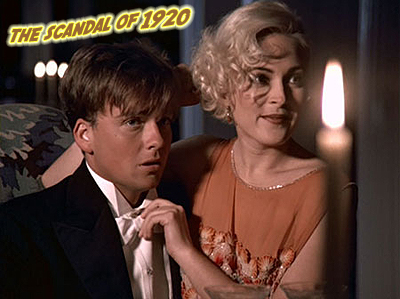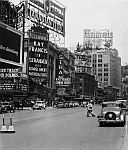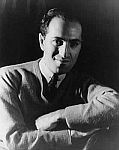Mystery of the Blues | Scandal of 1920 | Hollywood Follies
Young Indy Home
Chapter Overview

When summertime finally arrives, Indy packs up and leaves Chicago for Scandalous New York City. Once in Manhattan Indy accepts a summertime job as a stagehand for the Broadway play George White's Scandals. Indy's new friend, George Gershwin, gains inspiration for songs as he observes Indy's impressive attempt to balance three girlfriends at once. The changing roles of women are apparent in each girlfriend... Peggy is the aspiring actress from small town America, Kate is the independent and radical poet, and Gloria is the typical high society lady of the 1920's. When Scandals finally premieres, Indy finds that all three girls are in attendance and a hilarious frolic ensues. Adventures in dancing, singing, and musical scores highlight this tale of 1920's Broadway.
Key Topics: | 1920's New York; Tin Pan Alley; Broadway; Writing & Composing |
Historic People: | George Gershwin—Gershwin, along with his brother Ira, wrote many of the Jazz-infused classics that came out of Tin Pan Alley. Gershwin compositions include: I Got Rhythm, Rhapsody in Blue, & Porgy and Bess. |
People and Topics
DescriptorGershwin, along with his brother Ira, wrote many of the Jazz-infused classics that came out of Tin Pan Alley. Gershwin compositions include: I Got Rhythm, Rhapsody in Blue, & Porgy and Bess. BooksWyatt, Robert, John Andrew Johnson. The George Gershwin Reader. New York: Oxford University Press, 2004. Pollack, Howard. George Gershwin: His Life and Work. University of California Press, 2007. Websites |
DescriptorPerhaps the best known composer & lyricist to come out of Tin Pan Alley, Berlin wrote over 3,000 songs before his death in 1989. Berlin classics include: God Bless America, White Christmas, Anything You Can Do, and There's No Business Like Show Business. BooksBergreen, Laurence. As Thousands Cheer: The Life of Irving Berlin. Da Capo Press, 1996. Jablonski, Edward. Irving Berlin: American Troubadour. Henry Holt and Co., 1999. WebsitesJewish Virtual Library- Berlin Bio |
DescriptorA district of Manhattan, NYC where numerous composers and lyricists set up shop in the late 19th & early 20th century. Many "standards" came out of Tin Pan Alley. BooksFuria, Philip, Michael Lasser. America's Songs: The Stories Behind the Songs of Broadway, Hollywood, and Tin Pan Alley. New York: Routledge, 2006. Jasen, David A. Tin Pan Alley: An Encyclopedia of the Golden Age of American Song. New York: Routledge, 2003. Websites |
DescriptorThe Algonquin Round Table consisted of a group of writers, critics, wits, and actors who met at the Algonquin Hotel in New York City to gossip and inspire each others writings. For nearly ten years (1919 to 1929), the group met for lunch each day. BooksDrennan, Robert E., ed. The Algonquin Wits: Bon Mots, Wisecracks, Epigrams and Gags. New York: Carol Publishing Group, 1995. Gaines, James R. Wit's End: Days and Nights of the Algonquin Round Table. New York: Harcourt Brace Jovanovich, 1977. Websites |
DescriptorThe name Broadway refers to a wide (and very old) avenue in Manhattan with one section serving as the main district for American theater. This area of Broadway is often refered to as The Great White Way. Broadway is one of the longest avenues in New York City, stretching the entire length of Manhattan Island. BooksHenderson, Amy, Dwight Blocker Bowers. Red Hot and Blue: A Smithsonian Salute to the American Musical. Washington: Smithsonian Institute Press, 1996. Kantor, Michael, Laurence Maslon. Broadway: The American Musical. New York: Bulfinch Press, 2004. Websites |
Disclaimer: All resources (including books and websites) provided on indyintheclassroom.com are intended to be used by educators. Indyintheclassroom.com is not responsible for the content on linked websites.
Copyright: All images on Indyintheclassroom.com are used with permission or are in the public domain. Exceptions are noted. For additional information see our Copyright section. |
Documentary Previews
Below you will find information about each documentary that supplements The Scandal of 1920.
Tin Pan Alley: Soundtrack of America | Perhaps no artistic medium has acted as a more accurate cultural barometer than the popular song -- charting the nation's passions and pastimes with color and immediacy. In the early 20th century, Americans reveled in new found comfort, convenience and prosperity. A group of creative businessmen on Tin Pan Alley celebrated their arrival in song. Produced and Written by Adam Sternberg. Running Time: (0:31:15) |
Wonderful Nonsense: The Algonquin Round Table | "All the things I really like to do are either immoral, illegal or fattening." / "That woman speaks 18 languages and can't say no in any of them." / "Why don't you get out of that wet coat and into a dry martini?" / "Anything can happen, but it usually doesn't." / "Beauty is only skin deep, but ugly goes clean to the bone." -- New York City. 1920. The First World War was over. Flush with victory and dreams of riches, America was ready for something new. Manhattan was the place to be. New Yorkers were feeling confident and sassy. The connoisseurs of the new culture could be found at a daily lunch at a circular table inside a hotel called the Algonquin. They became known as the Algonquin Round Table. Produced and Written by Karena O'Riordan. Running Time: (0:26:00) |
Broadway: America Center Stage | The year was 1927, and the New York theater district called 'Broadway' was entering what would be its greatest season in history. More than 264 shows were going to open that year -- and as many as 11 would open on a single night. Every new production was an overflowing of talent that was expressly American. In the years following World War I, America's identity came into sharp focus, and it did so on the Broadway stage. Produced and Written by David O'Dell. Running Time: (0:29:58) |
Disclaimer: All resources (including books and websites) provided on indyintheclassroom.com are intended to be used by educators. Indyintheclassroom.com is not responsible for the content on linked websites.
Copyright: All images on Indyintheclassroom.com are used with permission or are in the public domain. Exceptions are noted. For additional information see our Copyright section. |
Indy Connections: The Scandal of 1920
Below are current event articles that relate to events, topics, and people found in The Scandal of 1920.
The History of the Flapper, Part 3: The Rectangular Silhouette
2/19/2013
If a woman in the 1920s had a boyish figure and was naturally skinny, she was all set to slip on a slim sheath, a signature look of the 1920s. But if she was plump and curvaceous, she might choose certain undergarments to help achieve the fashionable unisex flapper shape. The flapper silhouette was distinctive, and if you’re a fan of PBS’s “Downton Abbey,” you’ve seen it in full effect this season: angular (basically rectangular), androgynous, slender and straight. It was influenced by Braque, Picasso, Leger and others artists whose work had hard, geometric forms and visible lines.
The History of the Flapper, Part 2: Makeup Makes a Bold Entrance
Smithsonian.com
2/7/2013
In the decades before the Roaring Twenties, nice girls didn’t wear makeup. But that changed when flappers began applying cosmetics that were meant to be noticed, a reaction to the subdued and feminine pre-war Victorian attitudes and styles typified by the classic Gibson girl. Before the 1920s, makeup was a real pain to put on. It’s no wonder women kept it to a minimum. The tubes, brushes and compacts we take for granted today hadn’t yet been invented. Innovations in cosmetics in the ’20s made it much easier for women to experiment with new looks. And with the increasing popularity of movies, women could mimic the stars—like Joan Crawford, Mae Murray and Clara Bow, an American actress who epitomized the flapper’s spitfire attitude and heavily made-up appearance.
The History of the Flapper, Part 1: A Call for Freedom
Smithsonian.com
2/5/2013
In the age before the Roaring Twenties, women were still wearing floor-length dresses. Waists were cinched. Arms and legs were covered. Corsets were standard on a daily basis. Hair was long. The Gibson girl was the idealized image of beauty. And the Victorian attitudes toward dress and etiquette created a strict moral climate. Then the 1920s hit and things changed rapidly. The 19th Amendment passed in 1920 giving women the right to vote. Women began attending college. The Equal Rights Amendment was proposed by Alice Paul in 1923. World War I was over and men wanted their jobs back. Women, though, who had joined the workforce while the men were at war, had tasted the possibility of life beyond homemaking and weren’t ready to relinquish their jobs. Prohibition was underway with the passing of the 18th Amendment in 1919 and speakeasies were plentiful if you knew where to look. Motion pictures got sound, color and talking sequences. The Charleston’s popularity contributed to a nationwide dance craze. Every day, more women got behind the wheels of cars. And prosperity abounded.
Document Deep Dive: The Musical History of "The Star-Spangled Banner"
Smithsonian.com
6/13/2012
Most Americans are familiar with the story of how our national anthem, “The Star-Spangled Banner,” came to be. Francis Scott Key, a 35-year-old lawyer and budding poet from Washington, D.C., was in Baltimore in September 1814, when the British bombarded Fort McHenry. He successfully negotiated the release of an American prisoner there, but the British insisted that he stay on the truce ship President during the battle, from September 13-14. Just miles from Fort McHenry, Key watched what he would later describe as the “rocket’s red glare” and the “bombs bursting in air”—and come morning, the hoisting of an American flag at the fort in victory.
Broadway's Top Ten Musical Flops
Smithsonian.com
5/11/2011
In Mel Brooks' The Producers, washed-up theater producer Max Bialystock and wishy-washy accountant Leo Bloom figure they can get rich quick with a Broadway flop if they raise more money than they need to stage the show. (Their plan ultimately backfires and the pair end up in prison for fraud.) In real life, the creative minds that conspire to put on a show aim for greatness, but in the highly competitive New York theater scene, more shows bomb than succeed.
Summertime for George Gershwin
Smithsonian.com
8/9/2010
On June 16, 1934, George Gershwin boarded a train in Manhattan bound for Charleston, South Carolina. From there he traveled by car and ferry to Folly Island, where he would spend most of his summer in a small frame cottage. The sparsely developed barrier island ten miles from Charleston was an unlikely choice for Gershwin - a New York city-slicker accustomed to rollicking night life, luxurious accommodations and adoring coteries of fans. As he wrote his mother (with a bit of creative spelling), the heat "brought out the flys, and knats, and mosquitos," leaving there "nothing to do but scratch."
Jewish Songwriters, American Songs
Smithsonian.com
10/7/2009
By 1926, Cole Porter had already written several Broadway scores, "none of which had, well, scored," poet and critic David Lehman points out. But one enchanted evening that year, while dining in Venice with Noel Coward, Richard Rodgers and Lorenz Hart, Porter confided that he had finally figured out the secret to writing hits. "I'll write Jewish tunes," he said.
Disclaimer: All resources (including books and websites) provided on indyintheclassroom.com are intended to be used by educators. Indyintheclassroom.com is not responsible for the content on linked websites.
Copyright: All images on Indyintheclassroom.com are used with permission or are in the public domain. Exceptions are noted. For additional information see our Copyright section. |
Mystery of the Blues | Scandal of 1920 | Hollywood Follies
Young Indy Home





